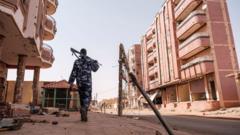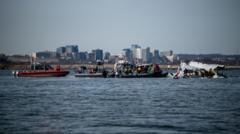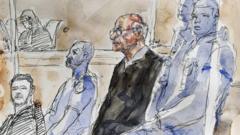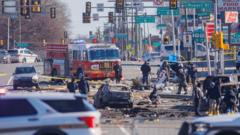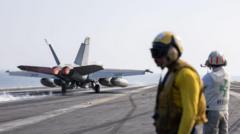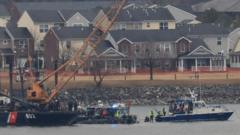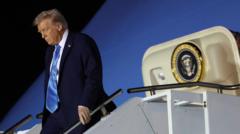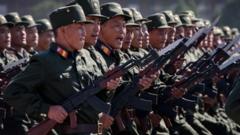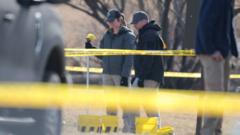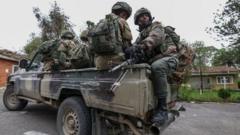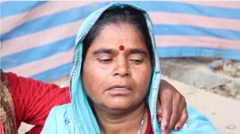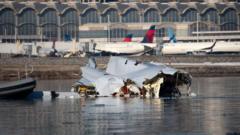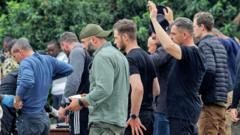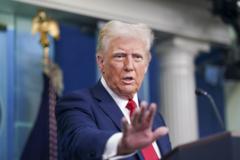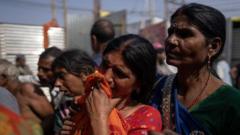In the early hours of New Year's Day, a vibrant celebration in New Orleans' French Quarter was shattered when a pick-up truck plowed into crowds, leading to devastation and chaos.
New Year's Nightmare: Tragedy Strikes New Orleans Celebration
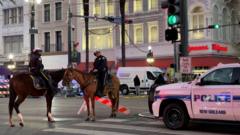
New Year's Nightmare: Tragedy Strikes New Orleans Celebration
A festive evening turned horrific as a vehicle attack leaves 15 dead and many injured.
At around 03:15 AM local time, the lively atmosphere in the city's party hub quickly transformed into a scene of panic and sorrow. Derrick Albert, a local DJ, recalled the vibrant crowd of young revelers—mostly in their teens and early twenties—who were enjoying the festive spirit. However, their excitement turned to terror as Shamsud-Din Jabbar, a 42-year-old Texas resident and US Army veteran, drove a rented truck full-speed into a crowded intersection, killing at least 15 individuals and injuring dozens more.
CCTV footage captured the chilling moment as the white vehicle sped past other cars and swerved around a police vehicle on Canal Street before careening into the throngs of people reveling in the New Year. Witnesses recounted the horrifying sounds of revving engines followed by the echoes of screams and crunching metal. The truck continued its chaotic path for three blocks until it came to a halt after crashing near Bourbon and Conti streets, where Jabbar emerged and opened fire on responding police officers. He was subsequently shot dead by law enforcement.
In the aftermath, responders were quick to assess the situation with police radio communications reporting multiple casualties within minutes of the attack. Officers sealed off the area as emergency services arrived amidst a flurry of activity to aid the injured and secure the crime scene.
The tragic incident has raised significant concerns regarding public safety measures in a locale known for its bustling nightlife. Questions have emerged about whether sufficient precautions were in place, especially since officials were aware of the vulnerability of crowded events to vehicular attacks, as noted in a 2017 memo. The Democratic National Convention and Mardi Gras were apparent risks cited, and now, many are scrutinizing the security protocols in place that night.
Despite the catastrophe, many within the community, including local business owners, expressed their resilience, stating confidently that New Orleans will recover and its vibrant culture will continue to thrive. The French Quarter, while still a scene of mourning, is slowly returning to life, with bars bustling with football fans celebrating the rescheduled Sugar Bowl, symbolizing the city’s enduring spirit amidst adversity.
Authorities continue to investigate the background of the attack, with the FBI disclosing that a black flag associated with the Islamic State was found inside the perpetrator's vehicle, alongside two suspected improvised explosive devices. The inquiry aims to unfold whether Jabbar acted independently or if he was part of a greater scheme.
As the investigation continues, the city remains united in remembering the victims and preparing to revive the festive spirit that defines New Orleans.
CCTV footage captured the chilling moment as the white vehicle sped past other cars and swerved around a police vehicle on Canal Street before careening into the throngs of people reveling in the New Year. Witnesses recounted the horrifying sounds of revving engines followed by the echoes of screams and crunching metal. The truck continued its chaotic path for three blocks until it came to a halt after crashing near Bourbon and Conti streets, where Jabbar emerged and opened fire on responding police officers. He was subsequently shot dead by law enforcement.
In the aftermath, responders were quick to assess the situation with police radio communications reporting multiple casualties within minutes of the attack. Officers sealed off the area as emergency services arrived amidst a flurry of activity to aid the injured and secure the crime scene.
The tragic incident has raised significant concerns regarding public safety measures in a locale known for its bustling nightlife. Questions have emerged about whether sufficient precautions were in place, especially since officials were aware of the vulnerability of crowded events to vehicular attacks, as noted in a 2017 memo. The Democratic National Convention and Mardi Gras were apparent risks cited, and now, many are scrutinizing the security protocols in place that night.
Despite the catastrophe, many within the community, including local business owners, expressed their resilience, stating confidently that New Orleans will recover and its vibrant culture will continue to thrive. The French Quarter, while still a scene of mourning, is slowly returning to life, with bars bustling with football fans celebrating the rescheduled Sugar Bowl, symbolizing the city’s enduring spirit amidst adversity.
Authorities continue to investigate the background of the attack, with the FBI disclosing that a black flag associated with the Islamic State was found inside the perpetrator's vehicle, alongside two suspected improvised explosive devices. The inquiry aims to unfold whether Jabbar acted independently or if he was part of a greater scheme.
As the investigation continues, the city remains united in remembering the victims and preparing to revive the festive spirit that defines New Orleans.

